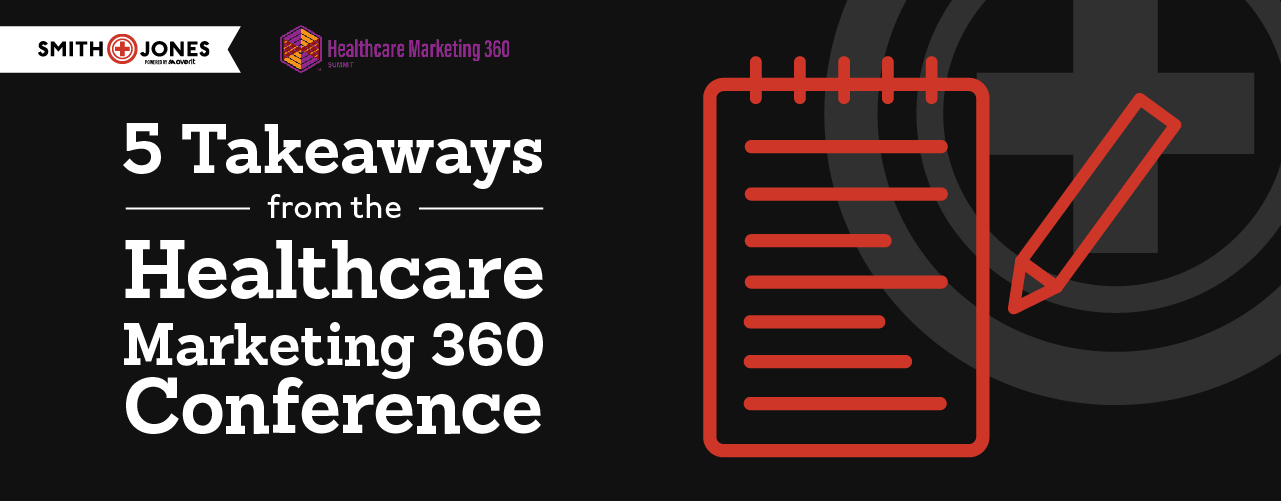5 Takeaways from the Healthcare Marketing 360 Conference
Last month, Smith & Jones content strategists Katie and Caitlin had the opportunity to travel to Nashville to attend the first annual Healthcare Marketing 360 Summit. This conference brought together marketing professionals from across the healthcare industry to explore the latest trends, strategies, and ideas shaping the future of healthcare marketing. The speakers encouraged us to “think like disruptors.” They challenged us to think outside the box, borrowing ideas from different industries and looking to the healthcare disruptors to see how we can improve and differentiate. Here are some of the top takeaways.
Personalization is possible (and necessary!)
We kicked off the conference with two workshops on consumer experience and personalization. When it comes to personalization of advertising materials, web experience, or email marketing, some healthcare leaders are hesitant because they don’t want to come off as “creepy” to a patient or consumer by knowing “too much” about them. And this is true to some degree. We don’t want to be Amazon with ads following us around the internet advertising a healthcare service. But we do want to be relevant and helpful.
Start small if you have no personalization or automation set up. Determine one area you’d like to change, improve, or support. Then, understand how your customer/patient journey aligns with these goals. Establish how you would define success. Then, try it! Remember, you WILL fail at one point or another. But without failure, you can’t learn how to improve and find a solution that works for you.
Consumer experience cannot be ignored
“Consumer experience” is another controversial topic in the healthcare space. Many doctors still refuse to call their patients “consumers.” However, it’s still important to remember that patients are consumers–they have choices and expectations. Especially for younger generations, as they have less loyalty to doctors or organizations than other generations might. They’re not afraid to take their “business” elsewhere if an experience doesn’t meet their expectations.
The speaker, Jared Johnson, explained the four pillars of consumer strategy; understand, design, build, and engage. You must be the voice of the consumer, understanding their wants and needs. Then, you must create the technology or experiences to meet those needs. Test, refine, and continue in a loop, always putting the consumer in the center.
Understand patient journeys through research
Of course, you cannot begin to understand customer experience or patient journeys without research. Agile, ongoing research is just as important as long-term, in-depth research. Think patient interviews, surveys, or monitoring online reviews. When creating a new web page or app, have a real patient try it to make sure they can navigate it and use it how you expect. Consider putting together a Patient Advisory Board to give feedback on projects and initiatives.
In Dean Browell’s presentation on digital ethnography, he also explained the importance of looking for feedback beyond standard channels like Facebook or Google Reviews. Reddit and TikTok comments can be a treasure trove of honest, unfiltered feedback. Also, look for specialized websites and forums related to specific diseases or conditions.
Denise Worrell reminded us that while mapping out patient journeys is important, we must also understand that there is no single journey. Within each service line, each individual experience is different. Instead of lumping everyone together into one generic experience, find the consistent pain points. Circumstances will differ, but the pain points people experience in your system will likely be the same. Once you’ve identified those pain points, you can then work to improve them.
Silos hurt everyone
Another topic brought up in multiple presentations was the idea of cross-functional collaboration. Traditional hospitals can be highly siloed, with marketing, internal communications, public relations, and human resources often working completely separately with little communication. This leads to fractured or contradicting brand messaging. In the discussion “Marketing’s Role in Recruiting for Success,” Amy Comeau, VP of Marketing at Emory Healthcare, suggested you may need to restructure your org chart to bring some of these departments together to break down silos.
In Peter Balistrieri’s presentation on cross-functional storytelling, he emphasized the importance of marketing and PR working together. Marketing and PR should have aligned goals and messaging. Working in tandem will allow both team’s efforts to go further and create cohesion and consistency for the brand.
AI should help us do our jobs (not replace them)
Whether you love or hate AI is most likely driven by your generational experiences and the media you consumed involving AI growing up (think Terminator, iRobot, Westworld, etc). While baby boomers may be more hesitant to jump into AI, your Gen Z employees are probably eager to go. But no matter where you fall, it’s important to remember that AI is not perfect. It can be purposely manipulated, and what it says is not necessarily true. So, creating content with it always needs to be edited and fact-checked.
By analyzing vast amounts of data, AI can help us with personalization, efficiency, patient insights, understanding patient experiences, and improving health outcomes. However, AI will never have empathy or the ability to make ethical or moral decisions, which is why we’ll always need human oversight in healthcare.
Presenter Keir Bradshaw also mentioned patients should be able to opt in or out of their data being used for AI. Some may have no issue, while others want more privacy. Organizations should always be transparent about how they’re using AI, so trust is not lost.
Looking to the future
As the healthcare landscape continues to evolve, these strategies will be instrumental in helping organizations navigate the challenges and opportunities ahead, ensuring they remain competitive and responsive to consumer needs. The consumer and patient must be at the center of everything we do, so we can keep giving patients the best care and the best experience.

